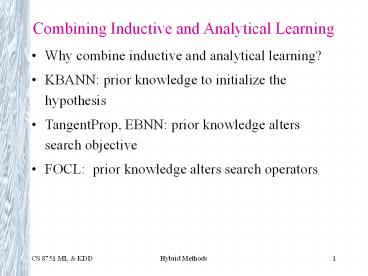Combining Inductive and Analytical Learning PowerPoint PPT Presentation
Title: Combining Inductive and Analytical Learning
1
Combining Inductive and Analytical Learning
- Why combine inductive and analytical learning?
- KBANN prior knowledge to initialize the
hypothesis - TangentProp, EBNN prior knowledge alters search
objective - FOCL prior knowledge alters search operators
2
Inductive and Analytical Learning
- Inductive learning
- Hypothesis fits data
- Statistical inference
- Requires little prior knowledge
- Syntactic inductive bias
Analytical learning Hypothesis fits domain
theory Deductive inference Learns from scarce
data Bias is domain theory
3
What We Would Like
- General purpose learning method
- No domain theory ? learn as well as inductive
methods - Perfect domain theory ? learn as well as
PROLOG-EBG - Accommodate arbitrary and unknown errors in
domain theory - Accommodate arbitrary and unknown errors in
training data
Inductive learning
Analytical learning
Plentiful data No prior knowledge
Scarce data Perfect prior knowledge
4
Domain Theory
- Cup ? Stable, Liftable, OpenVessel
- Stable ? BottomIsFlat
- Liftable ? Graspable, Light
- Graspable ? HasHandle
- OpenVessel ? HasConcavity, ConcavityPointsUp
Cup
Stable
Liftable
OpenVessel
Graspable
BottomIsFlat
Light
HasConcavity
ConcavityPointsUp
HasHandle
5
Training Examples
Cups
Non-Cups BottomIsFlat ? ? ? ? ? ? ?
? ConcavityPointsUp ? ? ? ? ? ? ?
Expensive ? ? ? ? Fragile ? ?
? ? ? ? HandleOnTop ? ?
HandleOnSide ? ? ?
HasConcavity ? ? ? ? ? ? ? ? ? HasHandle
? ? ? ? ? Light ? ? ? ? ? ? ? ?
MadeOfCeramic ? ? ? ?
MadeOfPaper ? ?
MadeOfStyroForm ? ? ? ?
6
KBANN
- Knowledge Based Artificial Neural Networks
- KBANN (data D, domain theory B)
- 1. Create a feedforward network h equivalent to B
- 2. Use BACKPROP to tune h to fit D
7
Neural Net Equivalent to Domain Theory
Expensive BottomIsFlat MadeOfCeramic MadeOfStyrofo
am MadeOfPaper HasHandle HandleOnTop HandleOnSide
Light HasConcavity ConcavityPointsUp Fragile
Stable Liftable OpenVessel
Cup
Graspable
large positive weight
large negative weight
negligible weight
8
Creating Network Equivalent to Domain Theory
- Create one unit per horn clause rule (an AND
unit) - Connect unit inputs to corresponding clause
antecedents - For each non-negated antecedent, corresponding
input weight w ? W, where W is some constant - For each negated antecedent, weight w ? -W
- Threshold weight w0 ? -(n - .5) W, where n is
number of non-negated antecedents - Finally, add additional connections with
near-zero weights - Liftable ? Graspable, Heavy
9
Result of Refining the Network
Expensive BottomIsFlat MadeOfCeramic MadeOfStyrofo
am MadeOfPaper HasHandle HandleOnTop HandleOnSide
Light HasConcavity ConcavityPointsUp Fragile
Stable Liftable OpenVessel
Cup
Graspable
large positive weight
large negative weight
negligible weight
10
KBANN Results
- Classifying promoter regions in DNA (leave one
out testing) - Backpropagation error rate 8/106
- KBANN 4/106
- Similar improvements on other classification,
control tasks.
11
Hypothesis Space Search in KBANN
Hypothesis Space
Hypotheses that fit training data equally well
Initial hypothesis for KBANN
Initial hypothesis for Backpropagation
12
EBNN
- Explanation Based Neural Network
- Key idea
- Previously learned approximate domain theory
- Domain theory represented by collection of neural
networks - Learn target function as another neural network
13
Explanation in Terms of Domain Theory
Prior learned networks for useful concepts
combined into a single target network
14
TangetProp
15
(No Transcript)
16
Hypothesis Space Search in TangentProp
Hypothesis Space
Hypotheses that maximize fit to data
Hypotheses that maximize fit to data and
prior knowledge
Backpropagation Search
TangetProp Search
17
FOCL
- Adaptation of FOIL that uses domain theory
- When adding a literal to a rule, not only
consider adding single terms, but also think
about adding terms from domain theory - May also prune specializations generated
18
Search in FOCL
Cup ?
Cup ? HasHandle 2,3-
...
Cup ? BottomIsFlat, Light,
HasConcavity, ConcavityPointsUp
4,2-
Cup ? HasHandle 2,3-
Cup ? Fragile 2,4-
...
Cup ? BottomIsFlat, Light,
HasConcavity, ConcavityPointsUp,
HandleOnTop 0,2-
Cup ? BottomIsFlat, Light,
HasConcavity, ConcavityPointsUp,
HandleOnSide 2,0-
Cup ? BottomIsFlat, Light,
HasConcavity, ConcavityPointsUp,
HandleOnTop 4,0-
19
FOCL Results
- Recognizing legal chess endgame positions
- 30 positive, 30 negative examples
- FOIL 86
- FOCL 94 (using domain theory with 76 accuracy)
- NYNEX telephone network diagnosis
- 500 training examples
- FOIL 90
- FOCL 98 (using domain theory with 95 accuracy)

